FE4055QA: Sainsbury's - Business & Economic Environment Analysis
VerifiedAdded on 2023/06/04
|8
|2044
|250
Report
AI Summary
This report provides an analysis of Sainsbury's business and economic environment, identifying the UK Standard Industrial Classification and discussing the influential elements shaping the industry. It examines Sainsbury's organizational structure and nature within the context of the retail industry. A STEEPLE analysis evaluates the external business factors affecting the company over the past 5-10 years, including social, technological, economic, environmental, political, legal, and ethical elements. The report also delves into microeconomic factors influencing demand, crucial elements of supply, and the competitiveness of the UK market. It addresses business problems and challenges faced by Sainsbury's, criticizing the external effects of business decisions on stakeholders and the public. The report concludes by summarizing key findings related to the UK's market competitiveness and potential random shocks impacting the government's fiscal policy.
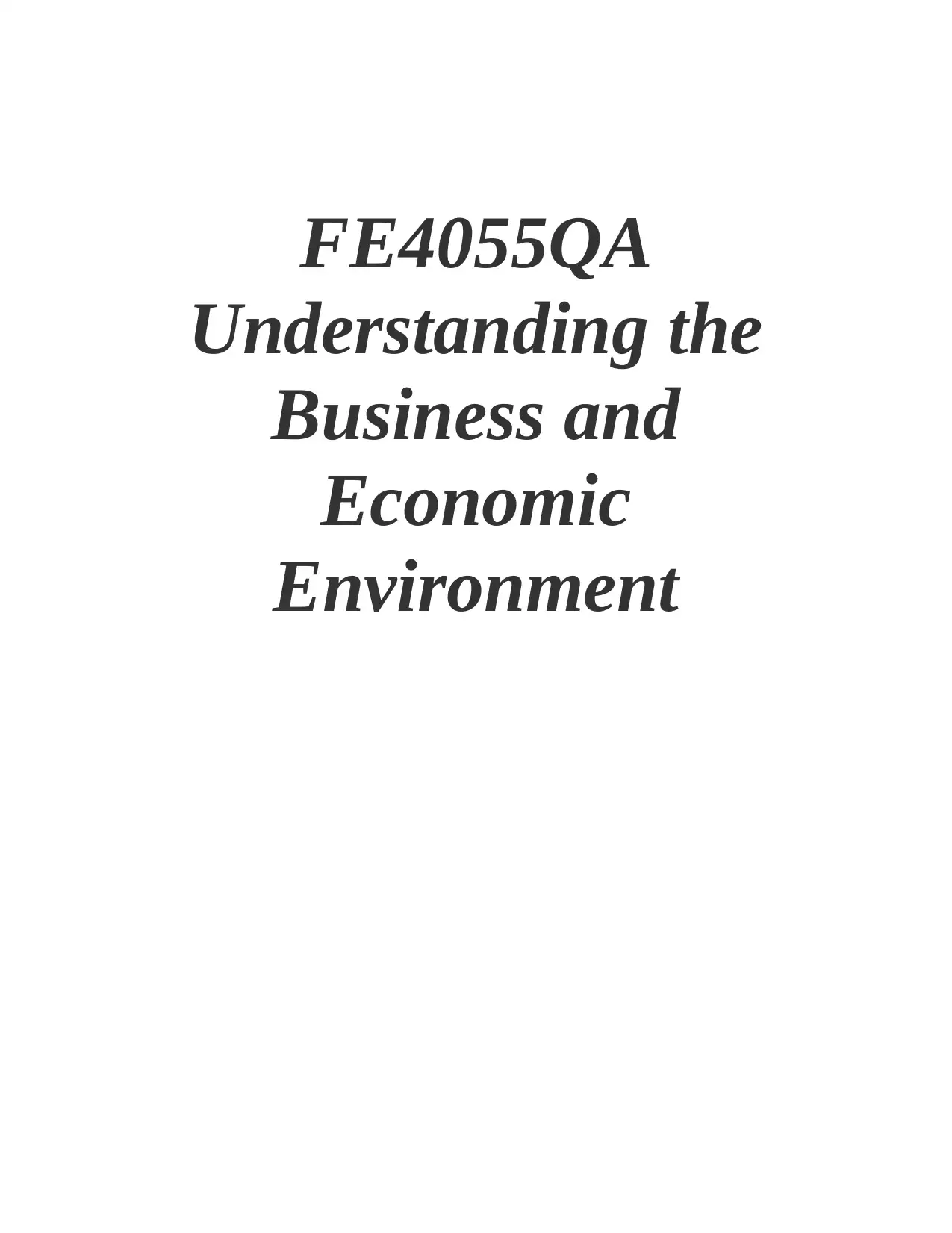
FE4055QA
Understanding the
Business and
Economic
Environment
Understanding the
Business and
Economic
Environment
Paraphrase This Document
Need a fresh take? Get an instant paraphrase of this document with our AI Paraphraser
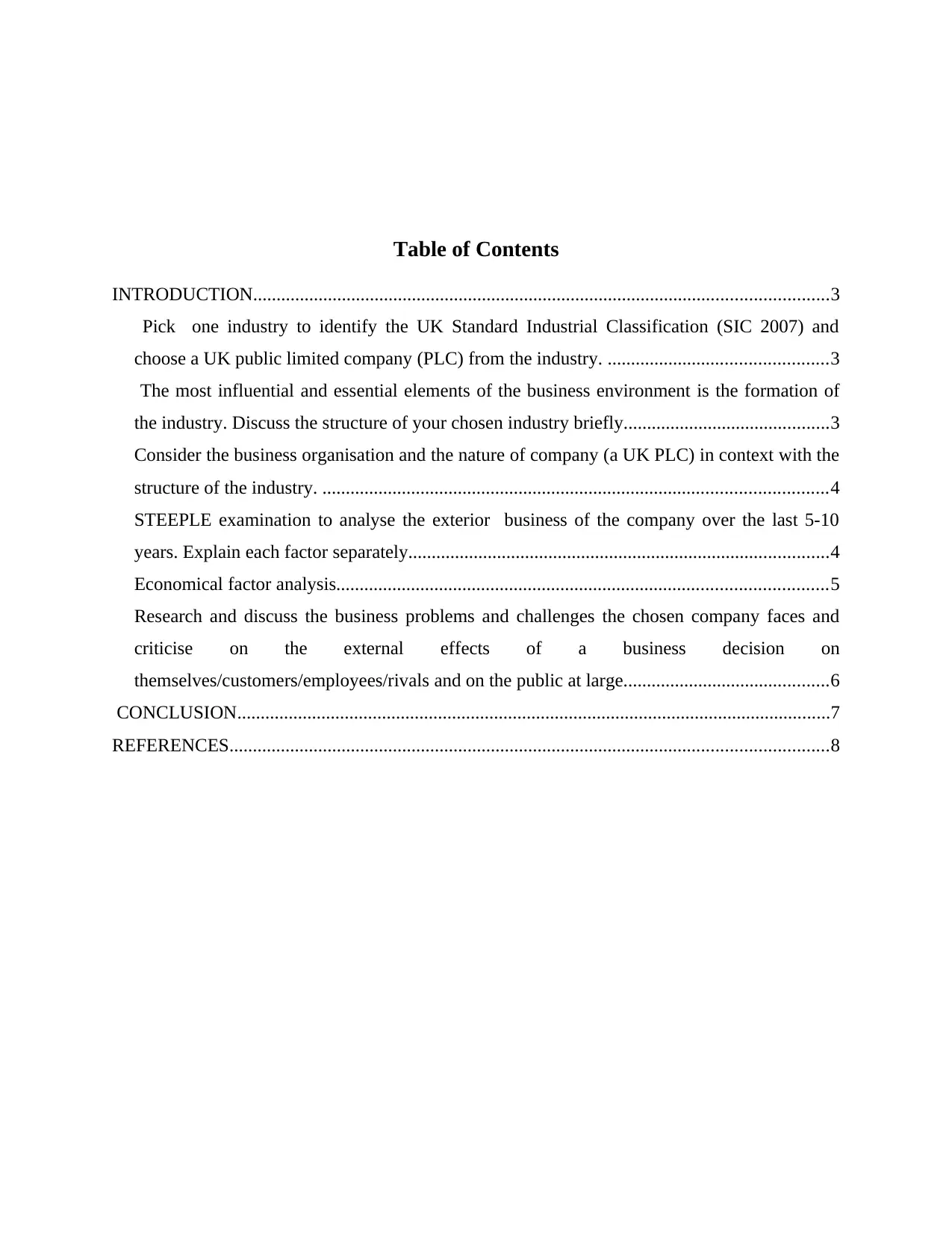
Table of Contents
INTRODUCTION...........................................................................................................................3
Pick one industry to identify the UK Standard Industrial Classification (SIC 2007) and
choose a UK public limited company (PLC) from the industry. ...............................................3
The most influential and essential elements of the business environment is the formation of
the industry. Discuss the structure of your chosen industry briefly............................................3
Consider the business organisation and the nature of company (a UK PLC) in context with the
structure of the industry. ............................................................................................................4
STEEPLE examination to analyse the exterior business of the company over the last 5-10
years. Explain each factor separately..........................................................................................4
Economical factor analysis.........................................................................................................5
Research and discuss the business problems and challenges the chosen company faces and
criticise on the external effects of a business decision on
themselves/customers/employees/rivals and on the public at large............................................6
CONCLUSION...............................................................................................................................7
REFERENCES................................................................................................................................8
INTRODUCTION...........................................................................................................................3
Pick one industry to identify the UK Standard Industrial Classification (SIC 2007) and
choose a UK public limited company (PLC) from the industry. ...............................................3
The most influential and essential elements of the business environment is the formation of
the industry. Discuss the structure of your chosen industry briefly............................................3
Consider the business organisation and the nature of company (a UK PLC) in context with the
structure of the industry. ............................................................................................................4
STEEPLE examination to analyse the exterior business of the company over the last 5-10
years. Explain each factor separately..........................................................................................4
Economical factor analysis.........................................................................................................5
Research and discuss the business problems and challenges the chosen company faces and
criticise on the external effects of a business decision on
themselves/customers/employees/rivals and on the public at large............................................6
CONCLUSION...............................................................................................................................7
REFERENCES................................................................................................................................8
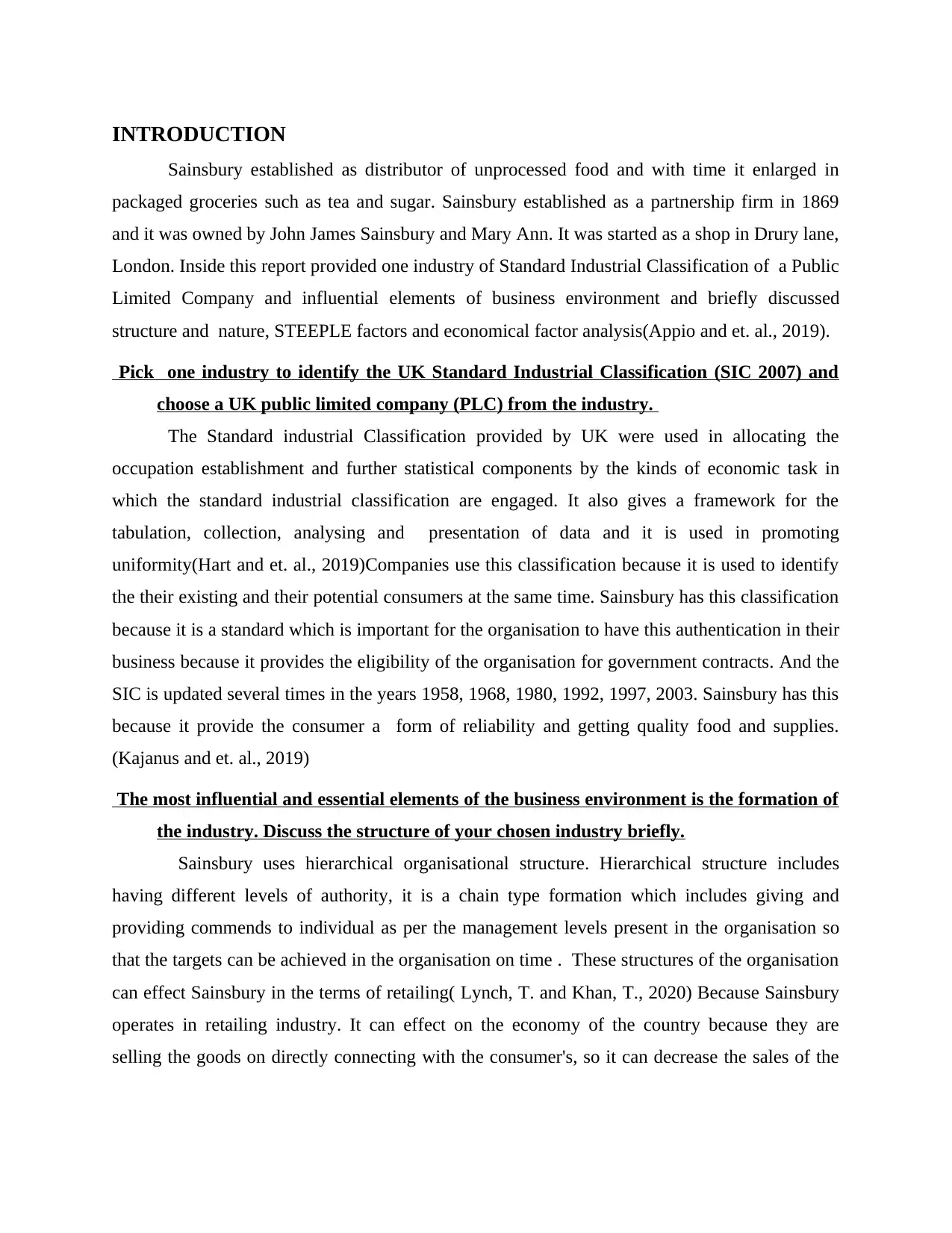
INTRODUCTION
Sainsbury established as distributor of unprocessed food and with time it enlarged in
packaged groceries such as tea and sugar. Sainsbury established as a partnership firm in 1869
and it was owned by John James Sainsbury and Mary Ann. It was started as a shop in Drury lane,
London. Inside this report provided one industry of Standard Industrial Classification of a Public
Limited Company and influential elements of business environment and briefly discussed
structure and nature, STEEPLE factors and economical factor analysis(Appio and et. al., 2019).
Pick one industry to identify the UK Standard Industrial Classification (SIC 2007) and
choose a UK public limited company (PLC) from the industry.
The Standard industrial Classification provided by UK were used in allocating the
occupation establishment and further statistical components by the kinds of economic task in
which the standard industrial classification are engaged. It also gives a framework for the
tabulation, collection, analysing and presentation of data and it is used in promoting
uniformity(Hart and et. al., 2019)Companies use this classification because it is used to identify
the their existing and their potential consumers at the same time. Sainsbury has this classification
because it is a standard which is important for the organisation to have this authentication in their
business because it provides the eligibility of the organisation for government contracts. And the
SIC is updated several times in the years 1958, 1968, 1980, 1992, 1997, 2003. Sainsbury has this
because it provide the consumer a form of reliability and getting quality food and supplies.
(Kajanus and et. al., 2019)
The most influential and essential elements of the business environment is the formation of
the industry. Discuss the structure of your chosen industry briefly.
Sainsbury uses hierarchical organisational structure. Hierarchical structure includes
having different levels of authority, it is a chain type formation which includes giving and
providing commends to individual as per the management levels present in the organisation so
that the targets can be achieved in the organisation on time . These structures of the organisation
can effect Sainsbury in the terms of retailing( Lynch, T. and Khan, T., 2020) Because Sainsbury
operates in retailing industry. It can effect on the economy of the country because they are
selling the goods on directly connecting with the consumer's, so it can decrease the sales of the
Sainsbury established as distributor of unprocessed food and with time it enlarged in
packaged groceries such as tea and sugar. Sainsbury established as a partnership firm in 1869
and it was owned by John James Sainsbury and Mary Ann. It was started as a shop in Drury lane,
London. Inside this report provided one industry of Standard Industrial Classification of a Public
Limited Company and influential elements of business environment and briefly discussed
structure and nature, STEEPLE factors and economical factor analysis(Appio and et. al., 2019).
Pick one industry to identify the UK Standard Industrial Classification (SIC 2007) and
choose a UK public limited company (PLC) from the industry.
The Standard industrial Classification provided by UK were used in allocating the
occupation establishment and further statistical components by the kinds of economic task in
which the standard industrial classification are engaged. It also gives a framework for the
tabulation, collection, analysing and presentation of data and it is used in promoting
uniformity(Hart and et. al., 2019)Companies use this classification because it is used to identify
the their existing and their potential consumers at the same time. Sainsbury has this classification
because it is a standard which is important for the organisation to have this authentication in their
business because it provides the eligibility of the organisation for government contracts. And the
SIC is updated several times in the years 1958, 1968, 1980, 1992, 1997, 2003. Sainsbury has this
because it provide the consumer a form of reliability and getting quality food and supplies.
(Kajanus and et. al., 2019)
The most influential and essential elements of the business environment is the formation of
the industry. Discuss the structure of your chosen industry briefly.
Sainsbury uses hierarchical organisational structure. Hierarchical structure includes
having different levels of authority, it is a chain type formation which includes giving and
providing commends to individual as per the management levels present in the organisation so
that the targets can be achieved in the organisation on time . These structures of the organisation
can effect Sainsbury in the terms of retailing( Lynch, T. and Khan, T., 2020) Because Sainsbury
operates in retailing industry. It can effect on the economy of the country because they are
selling the goods on directly connecting with the consumer's, so it can decrease the sales of the
⊘ This is a preview!⊘
Do you want full access?
Subscribe today to unlock all pages.

Trusted by 1+ million students worldwide
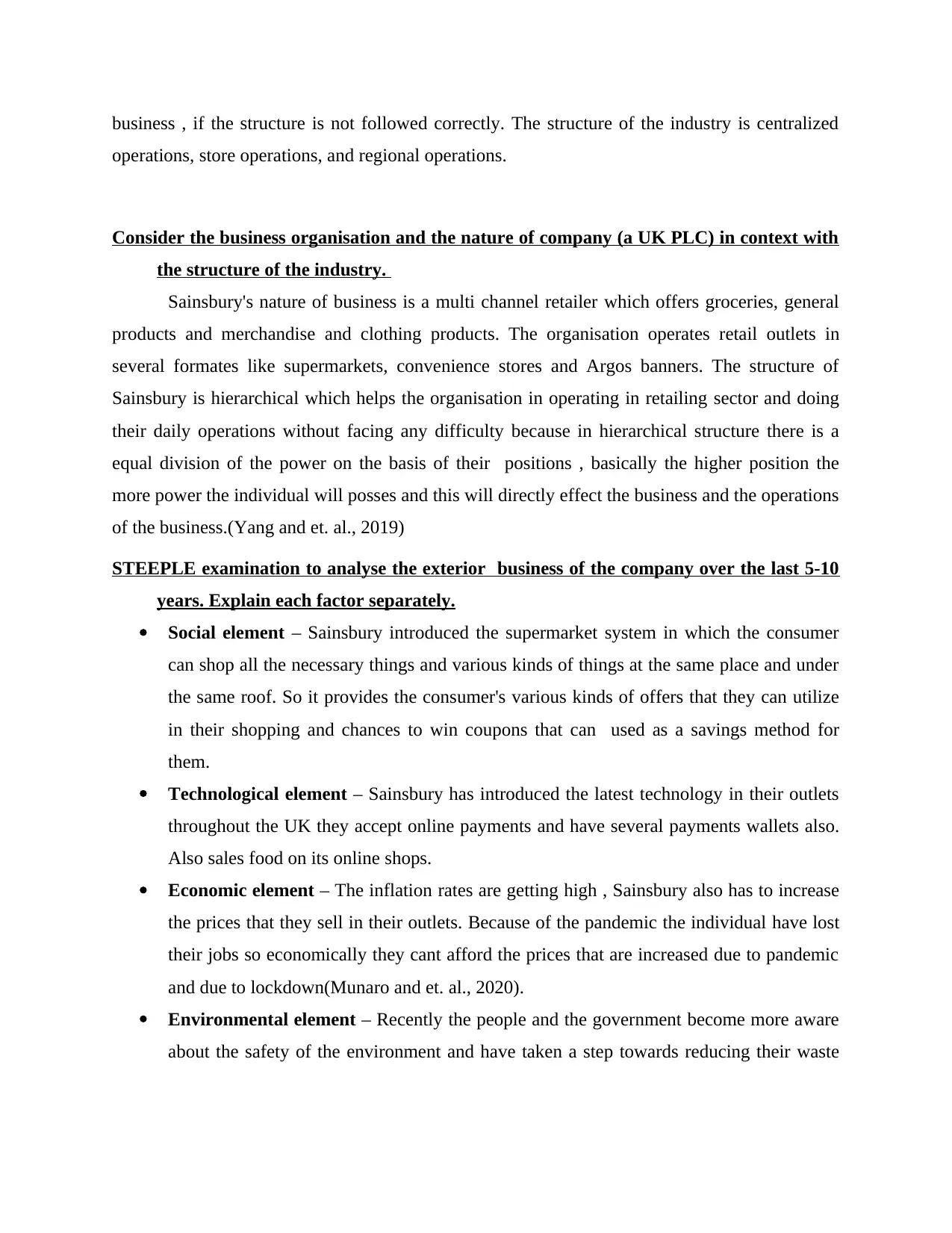
business , if the structure is not followed correctly. The structure of the industry is centralized
operations, store operations, and regional operations.
Consider the business organisation and the nature of company (a UK PLC) in context with
the structure of the industry.
Sainsbury's nature of business is a multi channel retailer which offers groceries, general
products and merchandise and clothing products. The organisation operates retail outlets in
several formates like supermarkets, convenience stores and Argos banners. The structure of
Sainsbury is hierarchical which helps the organisation in operating in retailing sector and doing
their daily operations without facing any difficulty because in hierarchical structure there is a
equal division of the power on the basis of their positions , basically the higher position the
more power the individual will posses and this will directly effect the business and the operations
of the business.(Yang and et. al., 2019)
STEEPLE examination to analyse the exterior business of the company over the last 5-10
years. Explain each factor separately.
Social element – Sainsbury introduced the supermarket system in which the consumer
can shop all the necessary things and various kinds of things at the same place and under
the same roof. So it provides the consumer's various kinds of offers that they can utilize
in their shopping and chances to win coupons that can used as a savings method for
them.
Technological element – Sainsbury has introduced the latest technology in their outlets
throughout the UK they accept online payments and have several payments wallets also.
Also sales food on its online shops.
Economic element – The inflation rates are getting high , Sainsbury also has to increase
the prices that they sell in their outlets. Because of the pandemic the individual have lost
their jobs so economically they cant afford the prices that are increased due to pandemic
and due to lockdown(Munaro and et. al., 2020).
Environmental element – Recently the people and the government become more aware
about the safety of the environment and have taken a step towards reducing their waste
operations, store operations, and regional operations.
Consider the business organisation and the nature of company (a UK PLC) in context with
the structure of the industry.
Sainsbury's nature of business is a multi channel retailer which offers groceries, general
products and merchandise and clothing products. The organisation operates retail outlets in
several formates like supermarkets, convenience stores and Argos banners. The structure of
Sainsbury is hierarchical which helps the organisation in operating in retailing sector and doing
their daily operations without facing any difficulty because in hierarchical structure there is a
equal division of the power on the basis of their positions , basically the higher position the
more power the individual will posses and this will directly effect the business and the operations
of the business.(Yang and et. al., 2019)
STEEPLE examination to analyse the exterior business of the company over the last 5-10
years. Explain each factor separately.
Social element – Sainsbury introduced the supermarket system in which the consumer
can shop all the necessary things and various kinds of things at the same place and under
the same roof. So it provides the consumer's various kinds of offers that they can utilize
in their shopping and chances to win coupons that can used as a savings method for
them.
Technological element – Sainsbury has introduced the latest technology in their outlets
throughout the UK they accept online payments and have several payments wallets also.
Also sales food on its online shops.
Economic element – The inflation rates are getting high , Sainsbury also has to increase
the prices that they sell in their outlets. Because of the pandemic the individual have lost
their jobs so economically they cant afford the prices that are increased due to pandemic
and due to lockdown(Munaro and et. al., 2020).
Environmental element – Recently the people and the government become more aware
about the safety of the environment and have taken a step towards reducing their waste
Paraphrase This Document
Need a fresh take? Get an instant paraphrase of this document with our AI Paraphraser
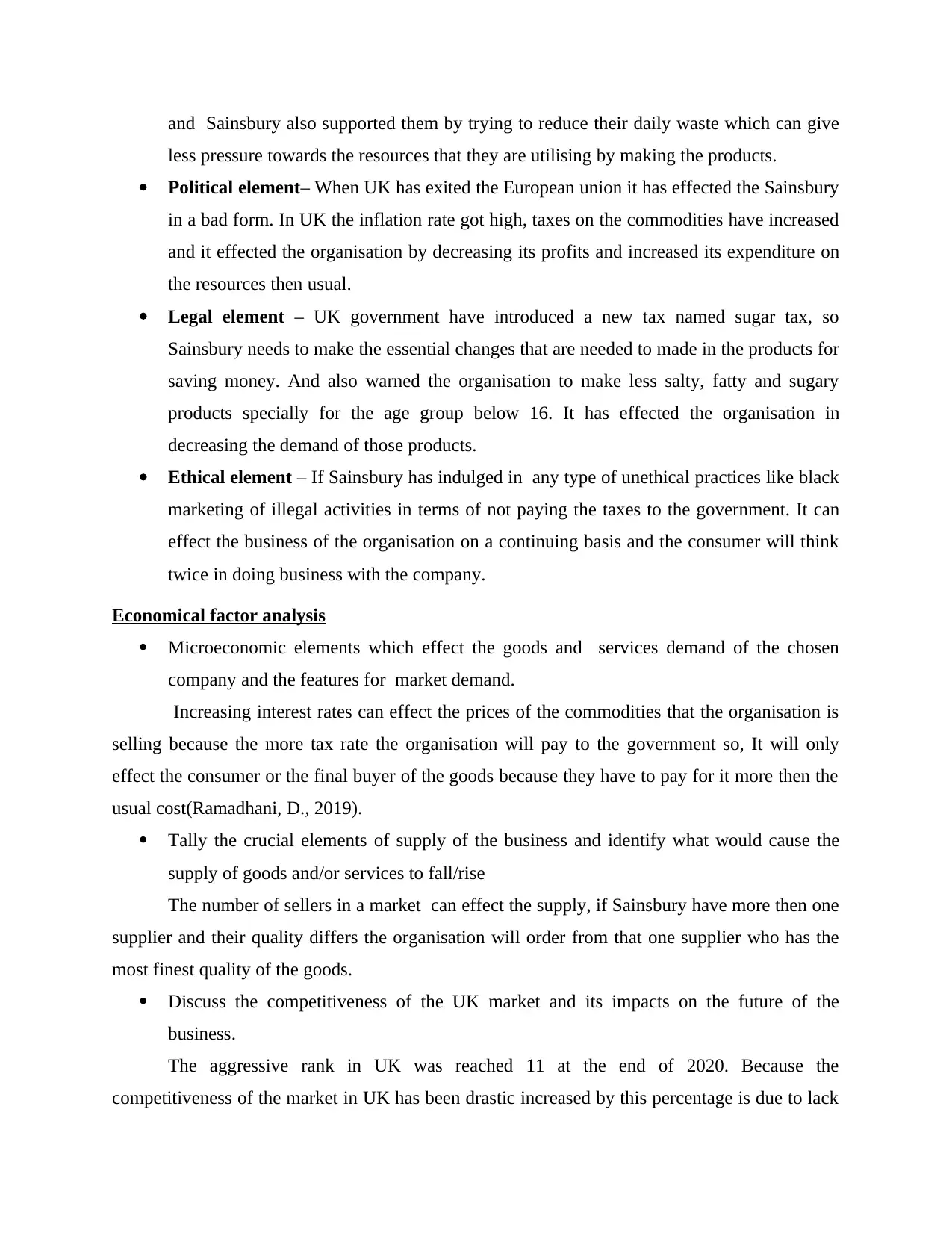
and Sainsbury also supported them by trying to reduce their daily waste which can give
less pressure towards the resources that they are utilising by making the products.
Political element– When UK has exited the European union it has effected the Sainsbury
in a bad form. In UK the inflation rate got high, taxes on the commodities have increased
and it effected the organisation by decreasing its profits and increased its expenditure on
the resources then usual.
Legal element – UK government have introduced a new tax named sugar tax, so
Sainsbury needs to make the essential changes that are needed to made in the products for
saving money. And also warned the organisation to make less salty, fatty and sugary
products specially for the age group below 16. It has effected the organisation in
decreasing the demand of those products.
Ethical element – If Sainsbury has indulged in any type of unethical practices like black
marketing of illegal activities in terms of not paying the taxes to the government. It can
effect the business of the organisation on a continuing basis and the consumer will think
twice in doing business with the company.
Economical factor analysis
Microeconomic elements which effect the goods and services demand of the chosen
company and the features for market demand.
Increasing interest rates can effect the prices of the commodities that the organisation is
selling because the more tax rate the organisation will pay to the government so, It will only
effect the consumer or the final buyer of the goods because they have to pay for it more then the
usual cost(Ramadhani, D., 2019).
Tally the crucial elements of supply of the business and identify what would cause the
supply of goods and/or services to fall/rise
The number of sellers in a market can effect the supply, if Sainsbury have more then one
supplier and their quality differs the organisation will order from that one supplier who has the
most finest quality of the goods.
Discuss the competitiveness of the UK market and its impacts on the future of the
business.
The aggressive rank in UK was reached 11 at the end of 2020. Because the
competitiveness of the market in UK has been drastic increased by this percentage is due to lack
less pressure towards the resources that they are utilising by making the products.
Political element– When UK has exited the European union it has effected the Sainsbury
in a bad form. In UK the inflation rate got high, taxes on the commodities have increased
and it effected the organisation by decreasing its profits and increased its expenditure on
the resources then usual.
Legal element – UK government have introduced a new tax named sugar tax, so
Sainsbury needs to make the essential changes that are needed to made in the products for
saving money. And also warned the organisation to make less salty, fatty and sugary
products specially for the age group below 16. It has effected the organisation in
decreasing the demand of those products.
Ethical element – If Sainsbury has indulged in any type of unethical practices like black
marketing of illegal activities in terms of not paying the taxes to the government. It can
effect the business of the organisation on a continuing basis and the consumer will think
twice in doing business with the company.
Economical factor analysis
Microeconomic elements which effect the goods and services demand of the chosen
company and the features for market demand.
Increasing interest rates can effect the prices of the commodities that the organisation is
selling because the more tax rate the organisation will pay to the government so, It will only
effect the consumer or the final buyer of the goods because they have to pay for it more then the
usual cost(Ramadhani, D., 2019).
Tally the crucial elements of supply of the business and identify what would cause the
supply of goods and/or services to fall/rise
The number of sellers in a market can effect the supply, if Sainsbury have more then one
supplier and their quality differs the organisation will order from that one supplier who has the
most finest quality of the goods.
Discuss the competitiveness of the UK market and its impacts on the future of the
business.
The aggressive rank in UK was reached 11 at the end of 2020. Because the
competitiveness of the market in UK has been drastic increased by this percentage is due to lack
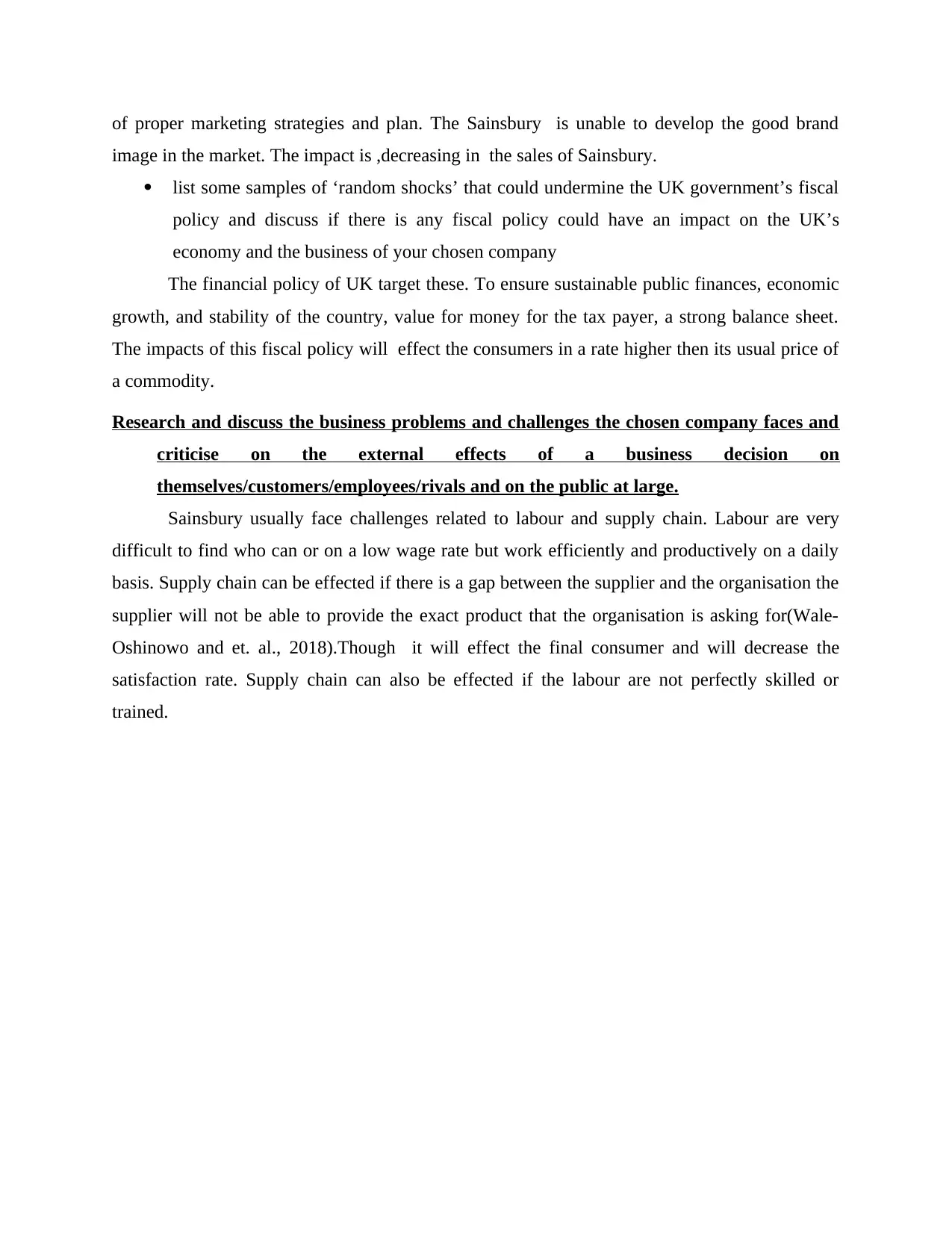
of proper marketing strategies and plan. The Sainsbury is unable to develop the good brand
image in the market. The impact is ,decreasing in the sales of Sainsbury.
list some samples of ‘random shocks’ that could undermine the UK government’s fiscal
policy and discuss if there is any fiscal policy could have an impact on the UK’s
economy and the business of your chosen company
The financial policy of UK target these. To ensure sustainable public finances, economic
growth, and stability of the country, value for money for the tax payer, a strong balance sheet.
The impacts of this fiscal policy will effect the consumers in a rate higher then its usual price of
a commodity.
Research and discuss the business problems and challenges the chosen company faces and
criticise on the external effects of a business decision on
themselves/customers/employees/rivals and on the public at large.
Sainsbury usually face challenges related to labour and supply chain. Labour are very
difficult to find who can or on a low wage rate but work efficiently and productively on a daily
basis. Supply chain can be effected if there is a gap between the supplier and the organisation the
supplier will not be able to provide the exact product that the organisation is asking for(Wale-
Oshinowo and et. al., 2018).Though it will effect the final consumer and will decrease the
satisfaction rate. Supply chain can also be effected if the labour are not perfectly skilled or
trained.
image in the market. The impact is ,decreasing in the sales of Sainsbury.
list some samples of ‘random shocks’ that could undermine the UK government’s fiscal
policy and discuss if there is any fiscal policy could have an impact on the UK’s
economy and the business of your chosen company
The financial policy of UK target these. To ensure sustainable public finances, economic
growth, and stability of the country, value for money for the tax payer, a strong balance sheet.
The impacts of this fiscal policy will effect the consumers in a rate higher then its usual price of
a commodity.
Research and discuss the business problems and challenges the chosen company faces and
criticise on the external effects of a business decision on
themselves/customers/employees/rivals and on the public at large.
Sainsbury usually face challenges related to labour and supply chain. Labour are very
difficult to find who can or on a low wage rate but work efficiently and productively on a daily
basis. Supply chain can be effected if there is a gap between the supplier and the organisation the
supplier will not be able to provide the exact product that the organisation is asking for(Wale-
Oshinowo and et. al., 2018).Though it will effect the final consumer and will decrease the
satisfaction rate. Supply chain can also be effected if the labour are not perfectly skilled or
trained.
⊘ This is a preview!⊘
Do you want full access?
Subscribe today to unlock all pages.

Trusted by 1+ million students worldwide
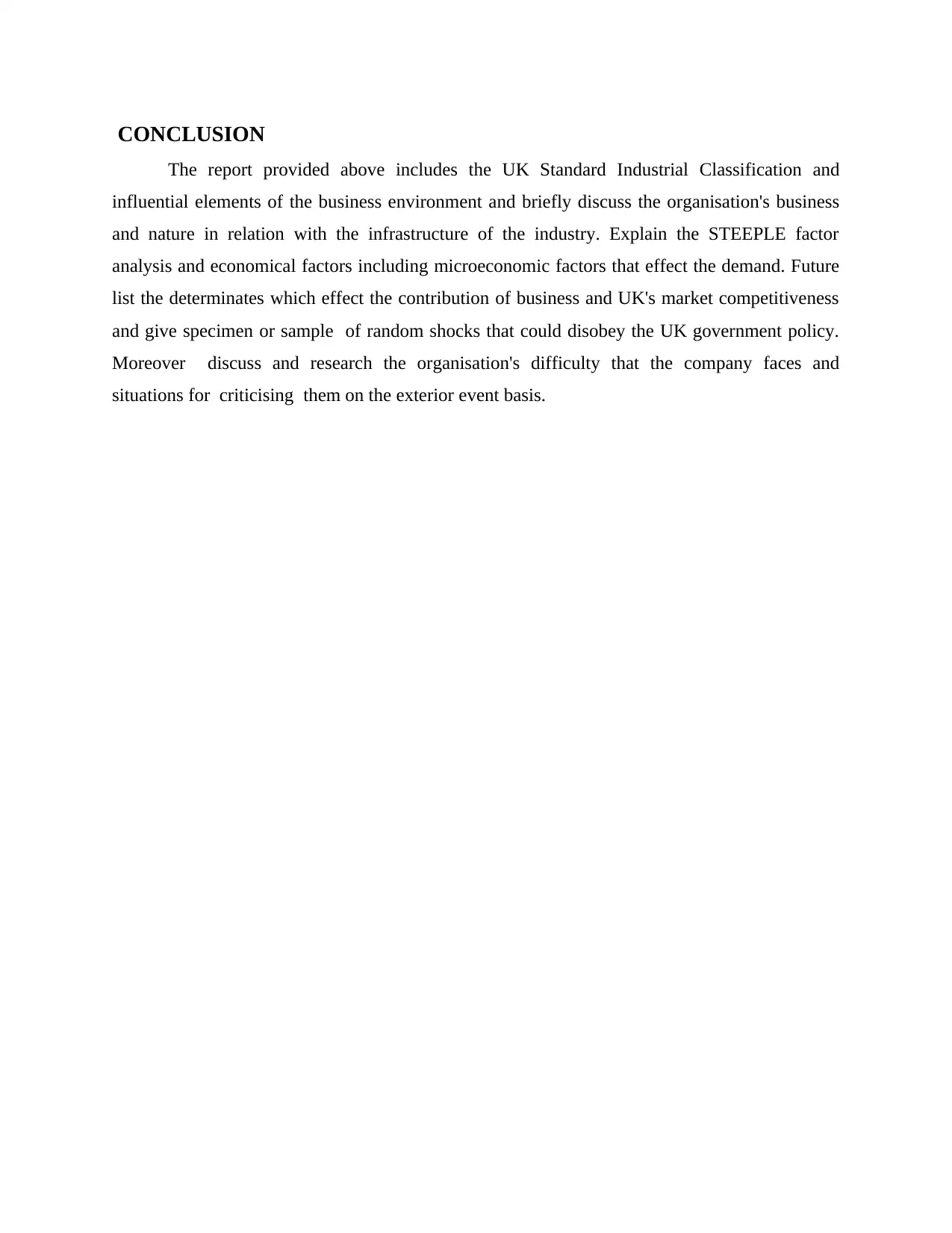
CONCLUSION
The report provided above includes the UK Standard Industrial Classification and
influential elements of the business environment and briefly discuss the organisation's business
and nature in relation with the infrastructure of the industry. Explain the STEEPLE factor
analysis and economical factors including microeconomic factors that effect the demand. Future
list the determinates which effect the contribution of business and UK's market competitiveness
and give specimen or sample of random shocks that could disobey the UK government policy.
Moreover discuss and research the organisation's difficulty that the company faces and
situations for criticising them on the exterior event basis.
The report provided above includes the UK Standard Industrial Classification and
influential elements of the business environment and briefly discuss the organisation's business
and nature in relation with the infrastructure of the industry. Explain the STEEPLE factor
analysis and economical factors including microeconomic factors that effect the demand. Future
list the determinates which effect the contribution of business and UK's market competitiveness
and give specimen or sample of random shocks that could disobey the UK government policy.
Moreover discuss and research the organisation's difficulty that the company faces and
situations for criticising them on the exterior event basis.
Paraphrase This Document
Need a fresh take? Get an instant paraphrase of this document with our AI Paraphraser
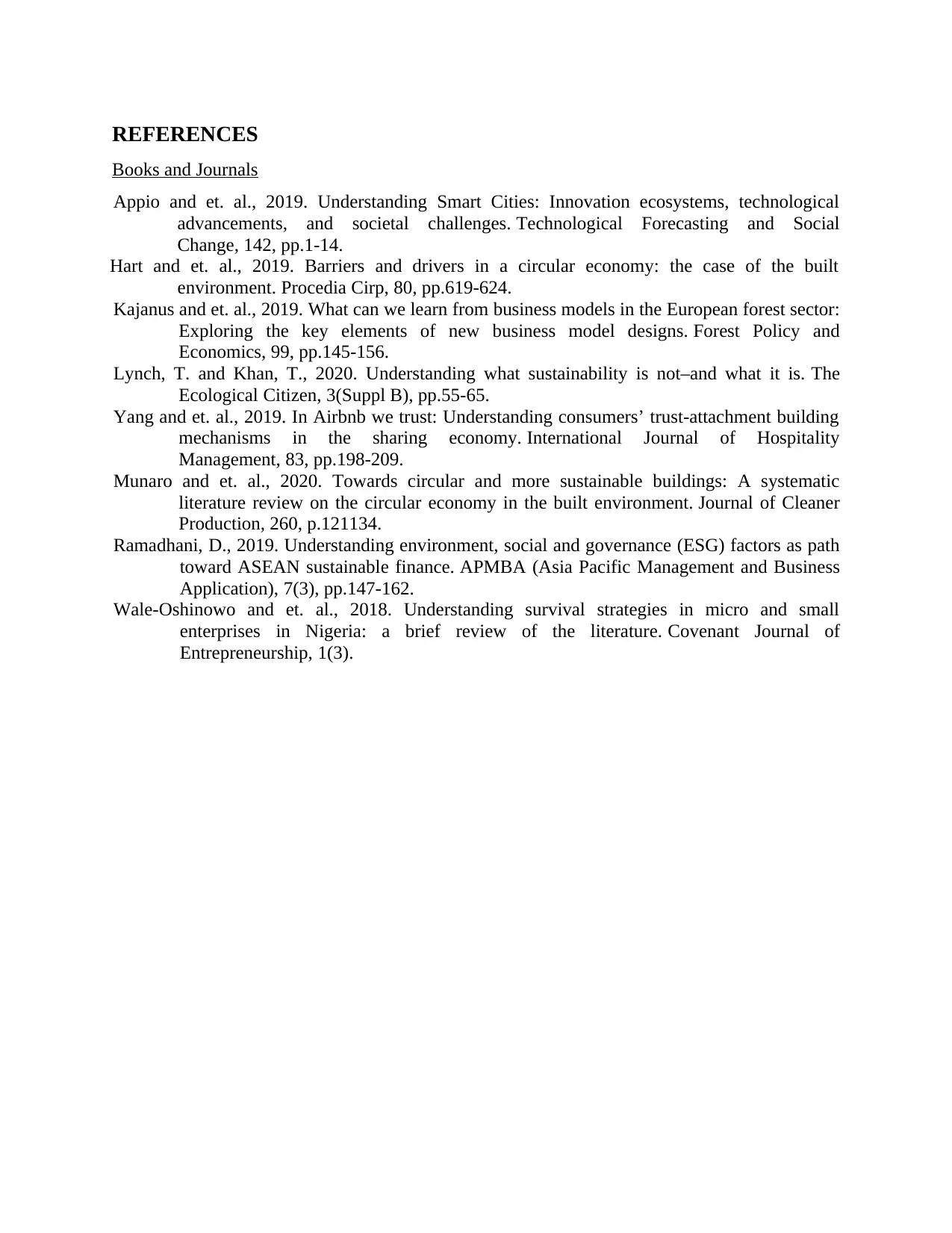
REFERENCES
Books and Journals
Appio and et. al., 2019. Understanding Smart Cities: Innovation ecosystems, technological
advancements, and societal challenges. Technological Forecasting and Social
Change, 142, pp.1-14.
Hart and et. al., 2019. Barriers and drivers in a circular economy: the case of the built
environment. Procedia Cirp, 80, pp.619-624.
Kajanus and et. al., 2019. What can we learn from business models in the European forest sector:
Exploring the key elements of new business model designs. Forest Policy and
Economics, 99, pp.145-156.
Lynch, T. and Khan, T., 2020. Understanding what sustainability is not–and what it is. The
Ecological Citizen, 3(Suppl B), pp.55-65.
Yang and et. al., 2019. In Airbnb we trust: Understanding consumers’ trust-attachment building
mechanisms in the sharing economy. International Journal of Hospitality
Management, 83, pp.198-209.
Munaro and et. al., 2020. Towards circular and more sustainable buildings: A systematic
literature review on the circular economy in the built environment. Journal of Cleaner
Production, 260, p.121134.
Ramadhani, D., 2019. Understanding environment, social and governance (ESG) factors as path
toward ASEAN sustainable finance. APMBA (Asia Pacific Management and Business
Application), 7(3), pp.147-162.
Wale-Oshinowo and et. al., 2018. Understanding survival strategies in micro and small
enterprises in Nigeria: a brief review of the literature. Covenant Journal of
Entrepreneurship, 1(3).
Books and Journals
Appio and et. al., 2019. Understanding Smart Cities: Innovation ecosystems, technological
advancements, and societal challenges. Technological Forecasting and Social
Change, 142, pp.1-14.
Hart and et. al., 2019. Barriers and drivers in a circular economy: the case of the built
environment. Procedia Cirp, 80, pp.619-624.
Kajanus and et. al., 2019. What can we learn from business models in the European forest sector:
Exploring the key elements of new business model designs. Forest Policy and
Economics, 99, pp.145-156.
Lynch, T. and Khan, T., 2020. Understanding what sustainability is not–and what it is. The
Ecological Citizen, 3(Suppl B), pp.55-65.
Yang and et. al., 2019. In Airbnb we trust: Understanding consumers’ trust-attachment building
mechanisms in the sharing economy. International Journal of Hospitality
Management, 83, pp.198-209.
Munaro and et. al., 2020. Towards circular and more sustainable buildings: A systematic
literature review on the circular economy in the built environment. Journal of Cleaner
Production, 260, p.121134.
Ramadhani, D., 2019. Understanding environment, social and governance (ESG) factors as path
toward ASEAN sustainable finance. APMBA (Asia Pacific Management and Business
Application), 7(3), pp.147-162.
Wale-Oshinowo and et. al., 2018. Understanding survival strategies in micro and small
enterprises in Nigeria: a brief review of the literature. Covenant Journal of
Entrepreneurship, 1(3).
1 out of 8
Related Documents
Your All-in-One AI-Powered Toolkit for Academic Success.
+13062052269
info@desklib.com
Available 24*7 on WhatsApp / Email
![[object Object]](/_next/static/media/star-bottom.7253800d.svg)
Unlock your academic potential
Copyright © 2020–2025 A2Z Services. All Rights Reserved. Developed and managed by ZUCOL.




